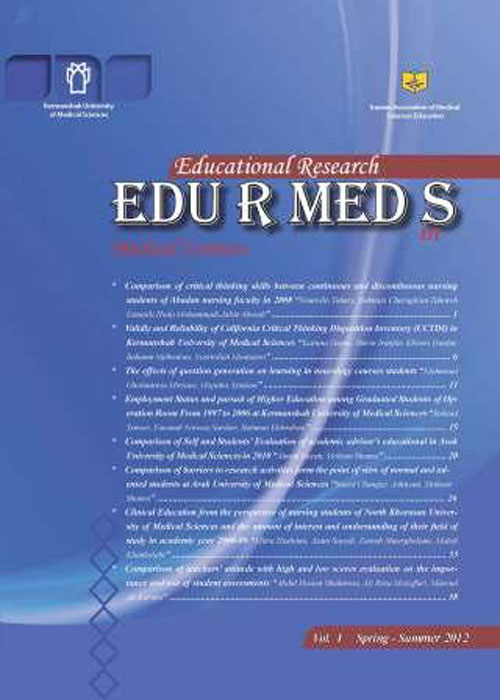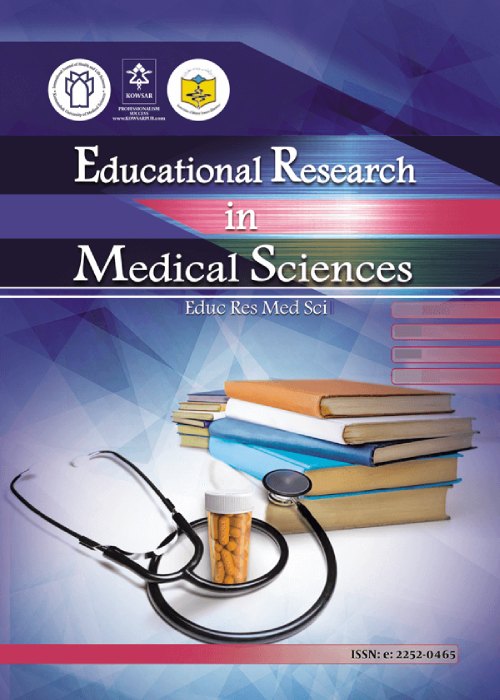فهرست مطالب

Educational Research in Medical Sciences
Volume:3 Issue: 2, Dec 2014
- تاریخ انتشار: 1393/04/01
- تعداد عناوین: 10
-
-
Pages 2-8IntroductionThe increasing development of software in e-learning has opened a new horizon in education. The current research was conducted to assess the effect of web-based teaching of anatomy course on medical students’ attitude, perceived ease of use, perceived benefit and satisfaction with teaching method at Kermanshah University of Medical Sciences.MethodsThe present study was an interventional quasi-experimental study that was carried out on medical students at Kermanshah University of Medical Sciences. The students were divided into two groups, one group was taught through web-based teaching method and the other one was taught via traditional teaching method. Data were collected by a researcher-made questionnaire with confirmed validity and reliability using self-report technique. The questionnaires were collected from the groups at the beginning and end of the semester. Data were analyzed by SPSS-21 software using chi-square, t-test and regression analysis and p<0.05 was considered significant.ResultsThe age range of the participants was 18-38 (19.82±2.06). The findings showed that 40.2% of the participants had experienced web-based learning. After intervention, the mean scores of perceived ease of use, perceived benefit, attitude and satisfaction with teaching method among the students receiving web-based teaching were significantly higher than the control group (p<0.05).ConclusionThe results of the current study indicated higher perceived ease of use and perceived benefit, more favorable attitude and higher satisfaction with the teaching method among the students taught through web-based teaching method, which might promote the quality of learning.Keywords: Web, Based Teaching, Anatomy, Medical Students
-
Pages 9-13IntroductionStudents are often similar in terms of learning ability and talent. However, there are remarkable differences in their academic performance during their schooling, which can be due to the differences in their academic motivation and achievement motivation. The current study was carried out to compare achievement motivation and academic achievement among the students of Kermanshah University of Medical Sciences (KUMS) in 2013.MethodsIn this descriptive Analytical cross-sectional study, the study sample included all students of KUMS studying in various majors in the academic year 2013-2014. A total of 301students (148 males and 163 females) were selected through stratified random sampling method. Herman’s achievement motivation scale and Vallerand’s academic motivation scale were used to collect the data. The obtained data were analyzed by SPSS-16 software using descriptive statistics (frequency, mean and standard deviation) and inferential statistics (one-way ANOVA and Scheffe’s post-hoc tests).ResultsThe mean of academic motivation among the studied sample was 116.73 ± 24.45. There was a significant difference between the students’ academic motivation and achievement motivation and their majors (p=0.006). The most motivated 125.37 ± 21.05 and the least motivated students 108.45 ± 26.87 were the medical students and undergraduate students of public health, respectively (p=0.001).ConclusionAn average academic motivation was reported for the students, and it was significantly different among various majors. Given the low academic motivation among the undergraduate students of public health and nursing, it seems necessary to take appropriate measures in order to improve their academic motivation.Keywords: Academic Motivation, Achievement Motivation, Students
-
Pages 14-17IntroductionEmotional intelligence is a key element that determines the achievement and efficiency of a person so that 80% of the achievement is dependent on it. The current research was carried out to determine the correlation between emotional intelligence and evaluation score of the faculty members of Kermanshah University of Medical Sciences (KUMS) in 2014.MethodsIn this analytical-descriptive and cross-sectional study, 150 faculty members of KUMS were selected as study sample through convenience sampling technique in 2014. The instruments for data collection included demographic information questionnaire, the mean scores of the faculty members’ evaluation reported by the students and Shrink emotional intelligence questionnaire. The collected data were fed into SPSS-21 software and analyzed by descriptive statistics, Pearson correlation coefficient, independent sample t-test and one-way ANOVA. P<0.05 was considered significant.ResultsEmotional intelligence was reported to be good in 133 (88.7%) faculty members, moderate in 15 (10%) faculty members and very good in 2 (1.3%) faculty members. There was a significantly positive correlation between emotional intelligence and the faculty members’ evaluation score reported by the students (p=0.047, r=0.28). No significant correlation, however, was reported between emotional intelligence and work experience, age, marital status and gender. The faculty members of the schools of health and pharmacy obtained the maximum and minimum levels of emotional intelligence, respectively (p=0.02).ConclusionThe emotional intelligence of the faculty members of KUMS was an acceptable level and was significantly correlated with their evaluation score.Keywords: Emotional intelligence, Faculty members, Evaluation
-
Pages 18-21The aim of the present study was to evaluate the efficiency of the computer and internet training course from the viewpoint of dental students of Kermanshah University of Medical Sciences in 2014. In this descriptive survey, the study sample included 39 dental students who entered university in 2011 and 2012. The required data were collected through a reliable and valid questionnaire using census sampling technique. Data were analyzed by SPSS 16 software. The administered training program obtained a high efficiency with a mean score of 57.8±9.5; However, there was no significant correlation between the mean of scores obtained by students and the mean score of efficiency of the given program (r=0.015, P=0.95). This training course can be helpfully used in evidence-based dental education and clinical decision making. It can also be used to develop the students’ motivation in education and research domainsKeywords: Efficiency, Training course, Dental students, Internet
-
Pages 22-24The aim of this study was to evaluate the status of health mangers’ evidence-based decision-making in Kermanshah University of Medial Sciences in 2013. In this descriptive - analytical survey, research tool was a 33-item questionnaire based on Kansas standard. The study sample was randomly drawn from among 180 experts, heads and deputies of health care centers in Kermanshah province. The collected data were analyzed deductively by SPSS 16. There was a significant difference between the number of times evidence-based decision making was used based on gender (P <0.023). However, no difference was observed in terms of management levels (P > 0.495). As a result, decision-making based on evidence has been accepted as a new reliable approach among medical staff of Kermanshah university of medical sciences and considered to improve the quality of evidence-based decision-making.Keywords: Evidence, based decision, making, Kansas questionnaire, Kermanshah University of Medical Sciences
-
Pages 25-27Proper sequencing of multiple choice test items is a matter of concern for many constructors. In this study we compared the variances of three different pharmacology test formats for nursing students. The aim of the study is to see if changing the order of questions will have any effect on the grades of the students. One way analysis of variance (ANOVA) was used to compare the mean score of the three groups and Levenes test was used to evaluate the equality of variances between them. The results confirm that the variances of the grades in all formats are homogeneous (P=0.141) and there is not a statistical difference between the mean scores in each of the three question formats (P= 0.566). It is conclusive that the performance of the nursing students in a pharmacology course does not change if item sequencing is not according to the course plan content sequence.Keywords: Multiple Choice Questions, Sequence, Performance
-
Pages 28-31Information and communication technologies play a fundamental role in modern life. In current study, statistical sample consisted of 46 pharmacy students of Kermanshah University of Medical Sciences who had been admitted in 2010 and randomly assigned into two groups for this study. Both groups were trained in two ways. In the beginning and in the end of the training period all students took a pre-test and post-test and a month later a test retention was performed. The data collection tool was a researcher made test which was used in all three stages. The results showed that there was no significant difference between the mean learning scores in the experimental group and the control group (p = 0.308) and between the retention scores of the two groups (p = 0.784). Based on the results of this study, the effect of using the wiki on higher levels of learning is recommended.Keywords: Learning, Students, Education, Web, Based


